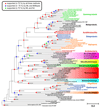Silvanigrella aquatica gen. nov., sp. nov., isolated from a freshwater lake, description of Silvanigrellaceae fam. nov. and Silvanigrellales ord. nov., reclassification of the order Bdellovibrionales in the class Oligoflexia, reclassification of the families Bacteriovoracaceae and Halobacteriovoraceae in the new order Bacteriovoracales ord. nov., and reclassification of the family Pseudobacteriovoracaceae in the order Oligoflexales
- PMID: 28771119
- PMCID: PMC5627705
- DOI: 10.1099/ijsem.0.001965
Silvanigrella aquatica gen. nov., sp. nov., isolated from a freshwater lake, description of Silvanigrellaceae fam. nov. and Silvanigrellales ord. nov., reclassification of the order Bdellovibrionales in the class Oligoflexia, reclassification of the families Bacteriovoracaceae and Halobacteriovoraceae in the new order Bacteriovoracales ord. nov., and reclassification of the family Pseudobacteriovoracaceae in the order Oligoflexales
Abstract
The unusual chemo-organoheterotrophic proteobacterial strain MWH-Nonnen-W8redT was isolated from a lake located in the Black Forest (Schwarzwald), Germany, by using the filtration-acclimatization method. Phylogenetic analyses based on the 16S rRNA gene sequence of the strain could not provide clear hints on classification of the strain in one of the current classes of the phylum Proteobacteria. Whole-genome sequencing resulted in a genome size of 3.5 Mbp and revealed a quite low DNA G+C content of 32.6 mol%. In-depth phylogenetic analyses based on alignments of 74 protein sequences of a phylogenetically broad range of taxa suggested assignment of the strain to a new order of the class Oligoflexia. These analyses also suggested that the order Bdellovibrionales should be transferred from the class Deltaproteobacteria to the class Oligoflexia, that this order should be split into two orders, and that the family Pseudobacteriovoracaceae should be transferred from the order Bdellovibrionales to the order Oligoflexales. We propose to establish for strain MWH-Nonnen-W8redT (=DSM 23856T=CCUG 58639T) the novel species and genus Silvanigrella aquatica gen. nov., sp. nov. to be placed in the new family Silvanigrellaceae fam. nov. of the new order Silvanigrellales ord. nov.
Conflict of interest statement
The authors declare the absence of any conflict of interest.
Figures




References
-
- Metchnikoff E. Contributions á l'etude du pleomorphisme des bacteriens. Annales de l'Institut Pasteur. 1889;3:61–8.
-
- Kip N, Fritz C, Langelaan ES, Pan Y, Bodrossy L, Pancotto V, et al. Methanotrophic activity and diversity in different Sphagnum magellanicum dominated habitats in the southernmost peat bogs of Patagonia. Biogeosciences. 2012;9(1):47–55.
-
- Shabarova T, Widmer F, Pernthaler J. Mass effects meet species sorting: transformations of microbial assemblages in epiphreatic subsurface karst water pools. Environ Microbiol. 2013;15(9):2476–88. - PubMed
MeSH terms
Substances
Grants and funding
LinkOut - more resources
Full Text Sources
Other Literature Sources
Molecular Biology Databases
Miscellaneous

